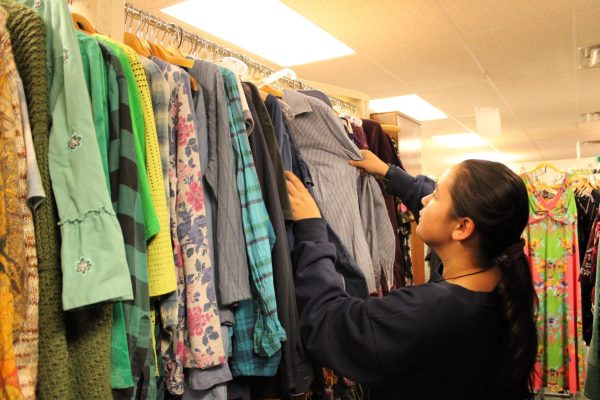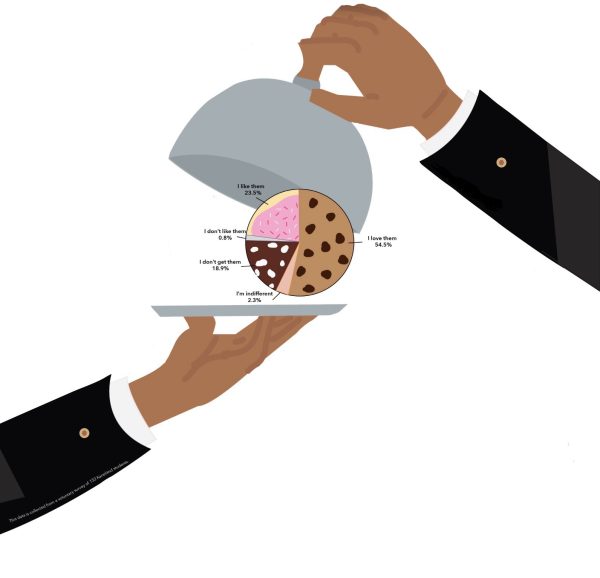Five finger discount has been taken all too literal
The five fingered discount a slang term usually used to describe the unjust of the slightest urge you get in the store to stuff your pockets, for the cost of “free 99”. For most the simplest pickpocket from a store can lead to a big problem. Not having enough money isn’t the issue; they might want more, and more and more.
Next thing they know, they are caught stealing. It could be as small as a pair of socks or as expensive as a new pair of Dre Beats headphones. Either way, it is a criminal offense.
“Think about hearing a song you like and instead of buying it on iTunes, you download it for free from a website, that’s basically taking money from the artist they can use for their livelihood and metaphorically putting it in to my ears” said Sophomore Sam Villano.
Teens have been infamous for leaving the store with a pocket full of items. The only issue is the items are not free, and taking them without paying is illegal.
According to Criminal Defence Lawyer, Illinois retail theft is defined as someone’s actions resulting in an unauthorized taking of property or services, along with the requisite intent of committing the crime. Shoplifting includes tampering with a price tag or label, switching merchandise to another container, making false returns, keeping an item past the expiration of lease and defeating an anti-theft device.
Who Steals
A shoplifter’s paradise of places to steal from can include department stores, specialty shops, supermarkets, drug stores, discounters, music stores, convenience stores and thrift shops.
Chris Springborn was a Sugar Grove police officer for eight years. In his experience of dealing with about 50 to 75 incidents of shoplifting, most thieves were between ages 16 and 25.
Dave Carlson has been working as a retail manager for over 20 years at Home Depot, Best Buy, Advanced Auto Parts and Pep Boys, and has had a fare share of amateur and professional shoplifters go through his stores.
“The measures and steps taken with shoplifters varied. Each store’s policy on it is different. You have to see the person walk into the store empty handed, grab and conceal the item and then not lose visual of the suspect the entire time,” Carlson said.
Although there is more to shoplifting than just teenagers and even the average adult; shoplifting, or organized retail crime, is becoming a realistic problem for all stores. Theft from these boosters or “resellers” can amount to losses as up to $37 billion annually, according to ABC news. That’s more than $35 million per day. This affects not only the offender if they caught, but also the store’s security expenses, costs consumers more for goods and costs communities lost dollars in sales taxes. Most employees often let shoplifters run when they are caught because they are either already of out the store or most stores do not want employees to sustain injuries.
The fact that most store employees let shoplifters get away with theft fuels these professional shoplifting rings or group of shoplifters who can at times get away with stealing for some time without ever being caught. Shoplifting rings are often in cooperation with fencing operations (operations that sell to the black market). One fencing operation can have up to more than 40 boosters, people who resell these stolen goods to the black market.
There are two types of shoplifters: professional and nonprofessional. The National Association for Shoplifting Prevention describes professional shoplifters as people who are addicts who steal to buy drugs or hardened criminals who steal for resale and profit as a lifestyle. Nonprofessionals are described as people who steal for a variety of reasons, mostly related to common life situations and their personal ability (or inability) to cope.
“The smart ones, they study everything. They know what they’re doing and plan everything out, and sometimes shoplift in teams. The dumb ones, usually kids, just take things off the shelf,” Carlson said.
According to ABC news recently a Chicago family’s decade long retail crime operation was tracked and busted. They stole $7.1 million worth of merchandise and managed to make up to $4.2, million selling items through their eBay accounts.
Carlson was keen about recalling an incident while he was working at a large outdoor retailer in which a man stole firearms from the store during a pretty busy hour in the firearm section.
“He picked up a good-sized shotgun case, walked over to a nice gun like a Beretta, looked around to see if anyone was watching, clipped the wire, and then put the gun in the case. He did this for a couple more guns. He then hid the cart and case away. After that he grabbed the same type of case, but with nothing in it and paid for it. He said he need to go talk to his buddy in the back, but actually switched the two cases out and walked out the door,” Carlson said.
The management saw him on the security tape, changed the arrangement in the front of the store within 12 hours, and caught him the next night when he attempted to do it again.
So if there are so many repercussions and expenses for both the offender and the store, why is shoplifting still continuing?
A few reasons to explain this offense are the addiction to stealing and psychological issues like depression, both that have shed light on shoplifting subjects.
Physiological Reasons
Carlson has heard of all the reasons in thebook on why they stole from his store. “I don’t have any money.” “I need to eat.” “I’m a victim.”
Although all of these seem basic, there is sometimes a substantial issue behind the cause.
Most people think of drugs or other illegal substances when they hear “addict,” but believe it or not, people can be addicted to shoplifting. According to the National Association for Shoplifting Prevention (NASP), 57 percent of adults and 33 percent of juveniles say it is hard for them to stop shoplifting, even after getting caught.
t all starts young. The NASP states that 25 percent of shoplifters are kids while 75 percent are adults. At first glance, one might think it is mostly adults that commit the offense; however, the catch is that out of the 75 percent, 55 percent of them say they started their bad habits as kids.
After getting away with shoplifting, a “rush” or “high” feeling is what some shoplifters consider the true reward instead of the stolen merchandise.
Just like drugs, it might take only one time for the offender to subdue to the power of addiction in shoplifting.
Of the shoplifters caught for the first time, 27 percent of shoplifters have already developed a shoplifting habit or even an addiction. The NASP states that drug addicts who have become addicted to shoplifting say that it is equally addictive as drugs.
Cocaine, one of the most addictive drugs in the world, becomes an addiction to 75 percent of people who have tried it for their first time. Although the dangers of shoplifting and the use of cocaine is nowhere near the same, the addiction is present, and can lead a user down the wrong road.
Along with addiction, there are the physiological problems. This includes Kleptomania and the most frequently found physiological problem in shoplifters is depression.
Peter Berlin, founder of NASP is also an international consultant on retail theft, publisher of newsletters for retailers and the criminal justice system and a former Director of Retail Security.
According to Berlin, several studies have found diagnosed depression to exist in approximately 1/3 of the shoplifters studied. Berlin also said that shoplifters perceive shoplifting as a form of self-nourishment or as a way to relieve fear or pain in their life. In truth, shoplifting is self-destructive, not self-nourishing, but shoplifters often don’t see the destructive path they are choosing to follow.
f there were a disorder or issue directly related to shoplifting, it would be Kleptomania. Kleptomania, defined by the Mayo Clinic, is the irresistible urge to steal items that generally aren’t needed and that usually have little value. It is also an impulse control disorder in which one cannot resist the temptation or drive to perform an act that’s harmful to him or herself and someone else.
In terms of shoplifting, most non-professional shoplifters view it as “getting something for nothing.” “A substitute for a loss” is another reason; this is when a person feels they were cheated on or deprived of something important like a death of a loved one, financial instability and a divorce. Stealing items from the retail stores will make them feel in control of the situation. The “relief mechanism” is a way to relieve anxiety, boredom and frustration.
Repercussions
The consequences of shoplifting can vary, as any other criminal offense can. A huge difference in getting caught is whether the offender is a minor or not. A minor offender is someone under aged who is charged with theft.
According to Springborn, community service or other forms of discipline not involving jail time are common consequences for minors.
“Each one is different, you have to take into account what the person is and what they stole,” Springborn said.
In Illinois, there are six classifications for theft with a range of criminal penalties. The most basic is a class A misdemeanor. This offence, commonly called petty theft is defined as stealing an object with a retail price under $500.
If convicted of a class A misdemeanor, the penalty is a maximum fine of $2,500 and a maximum of one year of imprisonment.
If the stolen item is taken out of an emergency exit, government owned, taken off a person, from a school or place of worship, then the offender could be charged in a higher classification.
The classifications after a class A misdemeanor are felonies and carry higher fines and jail time.
A merchant may choose to press civil charges to win money for the price of the stolen product and damages between $100 and $1,000.
The legal aspects of theft are not the only consequences; many of the thieves are documented in store, including name, address and a photo, and then are banned from the store indefinitely. Thieves may also be paraded through the store in handcuffs, even further humiliating them.
After all the debts have been paid, the long-term effects can still follow someone. Springborn stressed that it can change your life completely. It can affect applications for jobs, colleges and other positions. If caught again, a repeat offender will not have the benefit of the doubt as the first time.
“Once your name is in the system, they will look at you differently.” Springborn said.
“[Theft] can stick with you forever” Springborn said.











